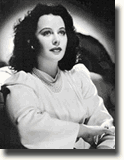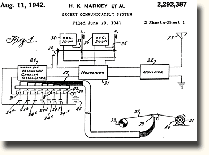Hedy Lamarr"Any girl can be glamorous. All she has to do is stand still and look stupid." --Hedy Lamarr
Hedy Lamarr defied the Hedy Lamarr was born in Vienna to a banker and concert pianist in 1914 as Hedwig Eva Maria Kiesler. She studied graphic arts at a private school. She dreamed of becoming an actress and in 1932 she got her break by her scandalous lead role in Ecstasy. Following her success as an actress she married Fritz Mandl, a wealthy Viennese munitions manufacturer. Mandl gave her everything she wanted except freedom. He even attempted to buy up every copy of Ecstasy. Despite his restrictive treatment, she was expected to entertain his Nazi weapons customers. It was here that she developed her hatred of Nazis. In 1937 she divorced him and went to London.
Her life was not all about Hollywood. While married to Mandl, she had learned about the need to control torpedoes to improve their efficacy. While at a party in Hollywood, she met George Antheil, an avant garde composer, and discussed her idea of controlling torpedoes with him. A torpedo can't be controlled by a wire trailing behind it because the wire would have to be too long. If the torpedo is controlled by radio, the enemy could simply jam the frequency. So Lamarr proposed "hopping" from one frequency to another continuously. Antheil contributed a way to keep the torpedo and the ship synchronized to hop to the same frequencies using piano player rolls as he had done to synchronize 16 pianos in his Ballet Mechanique. With the help of an electrical engineer, they devised a system of 88 frequencies, the same number of notes a piano has, which the torpedo and the ship would hop between in the same synchronized pattern using a piano player rolls to store the common pattern. Hedy Lamarr contributed both to America's cultural heritage and technological advancement. She showed that beauty does not preclude intelligence. |
German Page |
 Hollywood actress stereotype by co-inventing a communications system for torpedoes that demonstrated a technology that is the basis of much of modern military communications, cellular phones, and Internet access.
Hollywood actress stereotype by co-inventing a communications system for torpedoes that demonstrated a technology that is the basis of much of modern military communications, cellular phones, and Internet access. In London, Louis Mayer, the second M in
In London, Louis Mayer, the second M in 